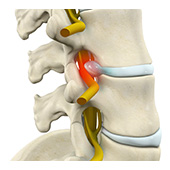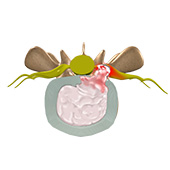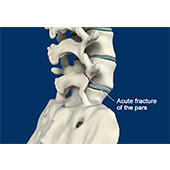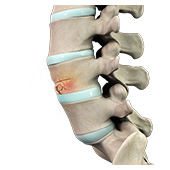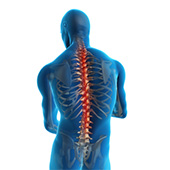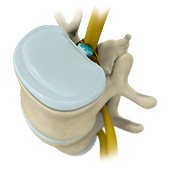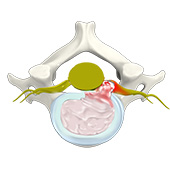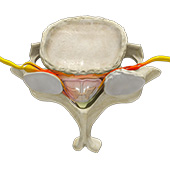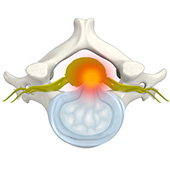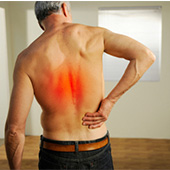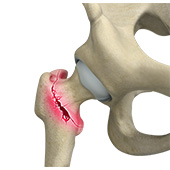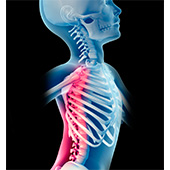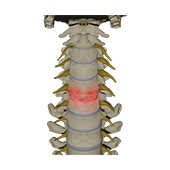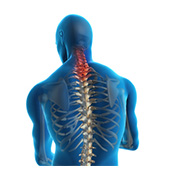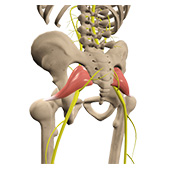- Anatomy
- Conditions
- Procedures
Lumbar Radiculopathy
Back pain is a common condition affecting approximately 80% of the population at some point in their lives. The area usually affected is the lower back (lumbar region) as it bears most of the upper body’s weight. Trauma to the spine, age and overuse can result in deterioration of the vertebral bones and joints or bulging of the discs. The resultant loss of space can lead to compression of the spinal nerve roots. Depending on the area being supplied by the nerve, symptoms are experienced in the lower extremities. Pain in the lower back may sometimes radiate to the legs. This is referred to as lumbar radiculopathy or sciatica.
Disc Herniation
Disc herniation is a condition where the central nucleus pushes through the outer edge of the disc, causing a bulge that compresses the spinal nerves.
Spondylolysis
Spondylolysis is a stress fracture in the vertebra that may progress into spondylolisthesis, a condition where the vertebra gets displaced from the spinal column. Spondylolysis is the cause of frequent low back pain in children. It is more common among children and teenagers who participate actively in sports such as football, weightlifting, and gymnastics.
Vertebral Compression Fractures
Back pain is an indication of stress fractures known as vertebral compression fractures. Vertebral compression fractures occur when the normal vertebral body of the spine is squeezed or compressed. The bone collapses when too much pressure is placed on the vertebrae, resulting in pain, limited mobility, loss of height and spinal deformity. In very severe compression fractures, the back of the vertebral body is pushed into the spinal canal and pressure is placed on the spinal cord.
Back Pain
Back pain or backache is the pain felt in the back that may originate from damage to the muscles, nerves, bones, joints or other structures in the spine. Back pain is one of the most common medical problems experienced by most people at some time in their life. It can be acute, usually lasting from a few days to a few weeks, or chronic, lasting for more than three months.
Sciatica
Sciatica is a painful condition caused by the irritation of the sciatic nerve. Sciatica can be acute (short term), lasting for a few weeks or chronic (long term), persisting for more than 3 months. It is important to understand that in most cases, sciatica will resolve itself within a few weeks or months and rarely causes permanent nerve damage.
Spine Injuries in Athletes
Spine injuries in athletes are defined as damage sustained by the spine as a result of physical trauma or overuse in people who are actively involved in sports. Sports activities have long been a source of spinal injuries. About 10 percent of all cases of spinal cord injuries in the United States has been linked to sports activities. Some of the common sports activities that are deemed high risk for fatal spinal injuries include football, rugby, wrestling, ice hockey, skiing, diving, snowboarding, motorsports, and cheerleading.
Cauda Equina Syndrome
What Cauda equina syndrome is an emergency condition characterized by persistent severe lower back pain caused by the compression of a bundle of spinal nerves (cauda equina) at the end of the spinal cord (lower back and hip region). If not treated promptly, it can lead to permanent paralysis of the legs, or bowel, bladder, and sexual problems.
Ankylosing Spondylitis
Sacroiliac joints are present in the lower back where the sacrum part of the vertebrae joins the iliac bones. The term ankylosis stands for loss of mobility of the spine, whereas spondylitis means inflammation of the spine. Therefore, ankylosing spondylitis is a condition where chronic inflammation of the spine and sacroiliac joint results in complete fusion of the vertebrae, leading to pain and stiffness in the spine.
Neck and Back Injuries
Neck and back injuries usually result from damage to the surrounding structures such as the muscles, bones, or ligaments of the neck and back. They are characterized by pain and discomfort and can sometimes be serious and result in permanent disability.
Neck Pain
Common neck pain may occur from muscle strain or tension from everyday activities including poor posture, prolonged use of a computer and sleeping in an uncomfortable position.
Cervical Herniated Disc
Herniation of a disc is an anomalous spine condition characterized by the bulging of the inner contents of the intervertebral disc due to cracks in its outer wall. A herniated disc is commonly seen in the cervical or neck region and is called cervical herniated disc (CHD). This condition is frequently reported in people between 30-40 years of age as well as elderly people.
Cervical Stenosis
Cervical stenosis refers to the narrowing of the spinal canal that protects the spinal cord and its branching nerves.
Cervical Disc Protrusion
Cervical disc protrusion, commonly known as a disc bulge, occurs when the spinal discs and associated ligaments are intact, but may form an outpouching that presses on the spinal nerves.
Low Back Pain
Low back pain is often a common symptom of many disease conditions and the back pain may range from simple or dull pain to sudden and sharp pain. If the pain persists for a few days, it is acute pain whereas if it continues for more than 3 months, it is considered as chronic pain. In most cases, low back pain may resolve without any treatment, however, if it persists for more than 3 days, medical intervention is necessary.
Mid-back Pain
Mid-back pain is also called as thoracic pain or upper back pain. It occurs at the back of the chest and is much less common than lower back pain. It may occur due to poor posture, muscle strain, improper lifting and bending, physical inactivity, sports injury, a trauma in a car accident, cancer, or an autoimmune disease.
Osteoporotic Fractures
steoporosis is a bone disorder where your bones become fragile and weak causing them to break easily. The condition occurs when your body starts losing bone or does not make enough bone or both, due to calcium deficiency. Osteoporosis is common in the spine. Osteoporotic fractures are breaks in your bones caused by osteoporosis. A mild fall or twisting and simple acts like bending over or coughing can result in fractures of your spinal bones due to osteoporosis.
Back Pain in Children
Back pain is uncommon in children and is usually associated with a serious underlying condition or an injury. Often, the cause of back pain is non-specific and is thought to be due to musculoskeletal strain, poor posture, heavy school bags that are not worn correctly or underlying mood problems.
Cervical Degenerative Disc Disease
Cervical degenerative disc disease (DDD) is a misnomer, as it is not a disease as such but a condition that affects the strength, resiliency and structural integrity of the intervertebral discs due to increasing age, trauma, injury, repetitive movement, improper posture, or poor body mechanics. Cervical DDD is commonly seen in adults after 50 years of age and most of them are usually not aware about their condition until they are examined for some other health condition.
Neck Strains and Sprains
The neck is the most flexible part of the spine and supports the weight of the head. The unique anatomical structure of the cervical vertebrae allows the free movement of the head. The neck is also composed of muscles and ligaments. Any excessive stress on the ligaments and muscles may injure or damage them.
Piriformis Syndrome
Piriformis Syndrome is an uncommon, rare neuromuscular condition caused by the compression of the sciatic nerve by the piriformis muscle. The sciatic nerve is a thick and long nerve that passes below or through the piriformis muscle and goes down the back of the leg and finally ends in the feet in the form of smaller nerves.

